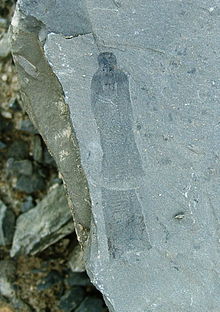- Ottoia
-
Ottoia
Temporal range: Burgess shale
Reconstruction of Ottoia in a burrow. The anterior portion of Ottoia, illustrating annulation and the eversible proboscis. Scientific classification 
Kingdom: Animalia Stem-group: Priapulida Class: †Archaeopriapulida Family: †Ottoiidae
Walott, 1911Genus: †Ottoia
Walcott, 1911Species - O. prolifica Walcott, 1911 (type)
Ottoia is the most abundant priapulid of the Cambrian Burgess Shale formation of British Columbia. It is a stem-group priapulid worm[1] that averaged about 80 mm in length.
Contents
Morphology
Ecology
Ottoia was a burrower that hunted prey with its eversible proboscis.[2] It also appears to have scavenged on dead organisms such as the arthropod Sidneyia.[3]
The spines on the proboscis of Ottoia have been interpreted as teeth used to capture prey. Its mode of life is uncertain, but it is thought to have been an active burrower, moving through the sediment after prey, and is believed to have lived within a U-shaped burrow that it constructed in the substrate. From that place of relative safety, it could extend its proboscis in search of prey. Gut contents show that this worm was a predator, often feasting on the hyolithid Haplophrentis (a shelled animal similar to mollusks), generally swallowed them head-first. They also show evidence of cannibalism, which is common in priapulids today.
Preservation
Because of its bottom living habit and the location of the Burgess Shale site at the foot of a high limestone reef, one may presume the relative immobility of Ottoia placed it in danger of being carried away and/or buried by any underwater mud avalanche from the cliff top. This may explain why it remains one of the more abundant specimens of the Burgess Shale fauna.
Distribution
At least 1000 Burgess Shale specimens are known in the UNSM collections alone,[4] in addition to the ROM collections and hundreds of specimens elsewhere. 677 specimens of Ottoia are known from the Greater Phyllopod bed, where they comprise 1.29% of the community.[5]
Ottoia is also known from Middle Cambrian deposits in Utah and Spain,[6] and Nevada.[7]
References
- ^ Budd, G. E.; Jensen, S. (2000). "A critical reappraisal of the fossil record of the bilaterian phyla". Biological Reviews of the Cambridge Philosophical Society 75 (2): 253–95. doi:10.1017/S000632310000548X. PMID 10881389.
- ^ Vannier, Jean (August 2009). "The Gut Contents of Ottoia (Priapulida) from the Burgess Shale: Implications for the Reconstruction of Cambrian Food Chains". In Smith, Martin R.; O'Brien, Lorna J.; Caron, Jean-Bernard. International Conference on the Cambrian Explosion (Walcott 2009). Abstract Volume. Toronto, Ontario, Canada: The Burgess Shale Consortium. 31st July 2009. ISBN 978-0-9812885-1-2. http://burgess-shale.info/abstract/vannier-2.
- ^ Bruton, D. L. (2001). "A death assemblage of priapulid worms from the Middle Cambrian Burgess Shale". Lethaia 34 (2): 163. doi:10.1080/00241160152418456.
- ^ Conway Morris, S (1977). "Fossil priapulid worms". Special papers in Palaeontology 20.
- ^ Caron, J. -B.; Jackson, D. A. (October 2006). "Taphonomy of the Greater Phyllopod Bed community, Burgess Shale". PALAIOS 21 (5): 451–465. doi:10.2110/palo.2003.P05-070R.
- ^ Conway Morris, S.; Robison, R. A. (1986). "Middle Cambrian priapulids and other soft-bodied fossils from Utah and Spain". University of Kansas Paleontological Contributions 117: 1–22. hdl:1808/3696. http://kuscholarworks.ku.edu/dspace/bitstream/1808/3696/1/paleo.paper.117.pdf.
- ^ Lieberman, B. S. (2003). "A New Soft-Bodied Fauna: the Pioche Formation of Nevada". Journal of Paleontology 77 (4): 674–690. doi:10.1666/0022-3360(2003)077<0674:ANSFTP>2.0.CO;2. ISSN 0022-3360.
External links
Categories:- Burgess Shale fossils
- Prehistoric invertebrates
- Cambrian animals
- Priapulida
Wikimedia Foundation. 2010.


